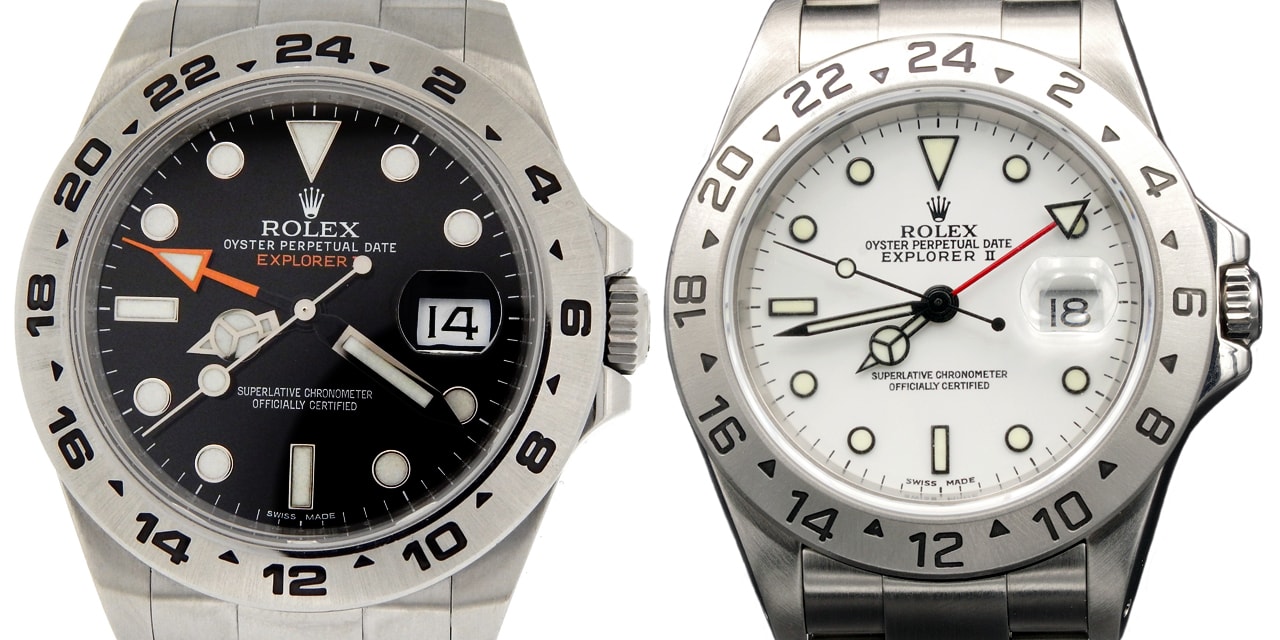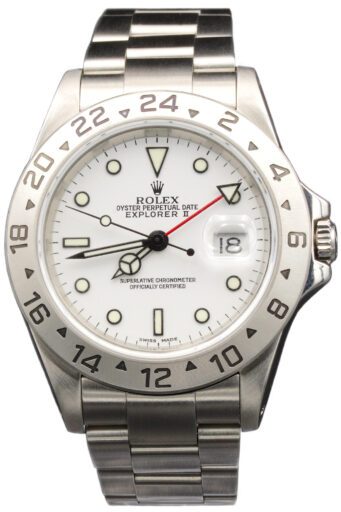The BeckerTime Guide to the Rolex Explorer II
Rolex had the two biggest and most profitable niche markets as they pertain to watches, diving and aviation, pretty much sewn up by the end of the 1960s.
The Submariner catered perfectly to the recreational underwater enthusiast and for those requiring more, the Sea-Dweller was a match for anything even the most hard-bitten professional could throw at it.
As for pilots, the Air-King was a beautifully austere yet highly readable companion, or else there was the GMT-Master, which had reached a level of popularity by then which almost rivalled the Sub’s, and came with a neat party trick which could literally be a lifesaver.
However, Rolex has long had a vested interest in a number of other fields; sports and occupational arenas practiced by those who might also be in need of a dedicated timepiece. And, as the calendar ticked over into the 1970s, they settled on a new avenue to explore.
A Spelunker of an Idea
While its namesake, the Explorer, came into being to celebrate man reaching heretofore unscaled heights, 1971’s sequel, the Explorer II, was created for adventurers who were going the other way; cave divers venturing into the bowels of the earth itself.
As a result, those two models look exactly nothing alike. Instead of the former, time-only, stripped-down semi-dress watch, the debut reference of the Explorer II, the ref. 1655, was about as toolish a model as Rolex had ever made.
At 39mm, it was 3mm larger than the original Explorer of the time. It also had an additional hour hand and a 24-hour engraved bezel but, unlike the other Rolex with those attributes, the GMT-Master, the Explorer II’s surround was fixed. That meant the watch couldn’t really be used as a dual time zone piece but was instead merely an AM/PM indicator. And that was all it needed to be. Underground, with no way to sight the sun, losing track of time is a common occurrence, and knowing whether your watch is telling you it is five o’clock in the morning or five o’clock at night is a handy way to stay oriented.
Even so, it is fair to say that the ref. 1655 was something of a dud on its release. It wasn’t just that its target market was an unusually small one, although it was. And it wasn’t simply because Rolex already made the GMT Master which was more versatile in its usage, although they did.
The real problem came down to its looks. It is unclear whether or not the brand was on a mission at the time to use up its entire surplus of tritium paint in one go, but gallons of it went on the Explorer II’s first dial. Sometimes known as the Disco Ball, there were no fewer than 24 lume plots in evidence, one every five minutes. Not only that, the three main hands were caked in the stuff, and the second hour hand was made particularly wide and stubby to hold even more.
Of course, being able to see your dial in the dark is a good thing, but the styling did not appeal to the average Rolex customer. The watch was set up to resemble a sighting compass, a vital tool used by spelunkers to map cave systems, with that extra hour hand made to look like a compass needle. What’s more, that bezel had no colorful insert to inject a dash of personality and so the reference tended to sit on dealers’ shelves while the more identifiable pieces were sold up around it. Even a completely spurious link with Hollywood royalty couldn’t help it shift in any decent numbers, and so the ‘Steve McQueen’ Rolex (SPOILER ALERT: he never wore one) was left to gather dust.
Until very recently, that has rather been the story of the Explorer II. The follow-up, the ref. 16550, came along in 1985, much improved with the inclusion of a new movement (the Cal. 3085) which allowed for the two hour hands to be set independently, meaning it could now operate as a true GMT. It also grew to 40mm and came with a white dial option, commonly called the Polar dial. Sadly, the decision was made to omit that bright orange hour hand from the original, the Freccione (Italian for ‘big arrow’), in favor of the same extra hand from the GMT Master. While it was distinctive in its own way, being bright red and arrow-tipped, it was in no way as prominent a trademark as the Freccione.
That transitional reference made way for the long running ref. 16570 in 1989 in order to accommodate another new movement, the Cal. 3185. Otherwise almost identical, the ref. 16570 lived on for 22-years and took the Explorer II up to its Jubilee.
In 2011, the model’s fortunes started to change for the better. The ref. 216570 brought the model into the modern age while casting its mind back to its beginnings. So the case dimensions grew again, this time to a contemporary yet still very wearable and 42mm, and the watch was given a Maxi dial, with extra-large lume plots and handset. At the same time, the Freccione was reinstated, that blast from the past which tapped into the craze for all things vintage. The upshot was a renewed interest in the former dark horse which has continued to this day.
The current reference, the ref. 226570 released in 2021, runs on the latest generation caliber, the Cal. 3285 and is arguably the most popular iteration of the Explorer II thus far. And the reason for that brings the model full circle. It was the overtly tool watch nature of the 1970s original which was commonly thought to be what held it back. Now, a half century later, with Rolex bringing out highly gentrified versions of their former exclusively steel catalog, it is the Explorer II’s ability to stick to its roots which appeals the most.
But which version is right for you?
If You Want the One That Started it All
The Rolex Explorer II ref. 1655
The first Explorer II was in production for 14 underwhelming years. However, that one-time flop of a watch is now considered something of a grail piece by many collectors, who prize it for its place in Rolex’s cultural canon as well as its visual eccentricities.
You might imagine, then, that the asking price for these originals would be sky-high but, in fact, they continue to be fairly reasonable; for now, at least.
It is true that you can spend a huge amount of money on a ref. 1655, especially if you have your heart set on one of the earliest of the five recognized dial ‘Marks’—sums in the six figure range are not unheard of for a MK I, for instance.
Yet later variants, those in the MK IV and V series, can still be had for around $20,000 or so.
For that, you get one of the most un-Rolex-like designs in the brand’s recent history; a throwback to an era when a mechanical watch, any mechanical watch, was first and foremost a working necessity rather than an accessory to project the wearer’s character.
The former ugly duckling ref. 1655 is now an example of effortless cool and demand only grows more intense every year.
If You Want One of Vintage Rolex’s Best Bargains
The Rolex Explorer II ref. 16570
The ‘80s and ‘90s were a rough time for the Explorer II. The confusion and antipathy around the first reference did not abate with the short lived follow-up, the ref. 16550, nor the follow-up to the follow-up, the two decade-enduring ref. 16570.
All were superb pieces, as you would expect, but merely out of their time.
However, what the 20+ years of the ref. 16570 did provide were an awful lot of units, making them today the lowest cost entry point into Explorer II ownership.
For around $8,000 you can pick up an excellent example of this former underdog and be comfortable in the knowledge you have a watch that is especially bombproof, even by Rolex standards.
The 40mm case is milled from a single block of steel, a sapphire crystal nearly as unbreakable as diamond covers the dial and a thoroughly modern Oyster bracelet with Solid End Links makes sure the whole thing stays on your wrist. Inside, the majority of the run was powered by the Cal. 3185, a movement from the legendary Cal. 31XX series which set the benchmark for precision and reliability in mass-produced luxury watch movements. Post-2006, that movement changed to the Cal. 3186 which introduced the Parachrom Bleu hairspring and eliminated the notorious but not in any way important handslop of the earlier examples.
And up front, you have the choice between the sexy covertness of the black dial or the brightly eye-catching Polar, both no-nonsense, highly readable faces designed for practicality rather than status.
A gem of a watch at a price which is hard to believe, the ref. 16570 is a rare vintage bargain.
If You Want the Best of the Modern Day
The Rolex Explorer II ref. 216570
The Explorer II isn’t the only cult hero in Rolex’s stable, but it has been arguably the most successful of those second tier offerings from the crown.
Names like the Milgauss, the Turn-O-Graph and the Air-King spring to mind, underserved models which have all been discontinued at one point or another and, in some cases, reinstated briefly only to be withdrawn again.
But even though the Explorer II has sometimes struggled for an audience, it has remained a constant presence in the catalog for over half a century now, so it must be doing something right.
One of the latest references, the ref. 216570, can take credit for much of the renewed interest in the cave divers’ friend. While it is unmistakably a continuation of the species, with all the most important styling elements still front and center, its 2011 release actually came with what is, for Rolex, a major redesign.
The case grew to a more fitting size for a 21st century tool watch, 42mm, and the dial furniture ballooned as well, with big, fat hands and comparatively enormous hour markers. The Freccione made a massively popular comeback (and did far more than its fair share in making the ref. 216570 a real winner on its unveiling) and the caliber was upgraded to the Cal. 3187. Physically larger than the former Cal. 3186 which was still being used in the GMT-Master II of the time, the
Cal. 3187 came with Rolex’s own Paraflex shock absorption system for the last word in protection.
The bracelet is the best version of the Oyster Rolex has so far released, with all solid links lending it a reassuring heft, and the whole watch is visually perfectly balanced. More than that, it has now become cool.
Nevertheless, the ref. 216570 remains one of the most temptingly priced examples of any of the range, with genuine pieces going for as little as $12,000 on the preowned market. A huge amount of watch for a realistic amount of money, it is difficult one to beat.
Featured Photo: BeckerTime’s Archive.










